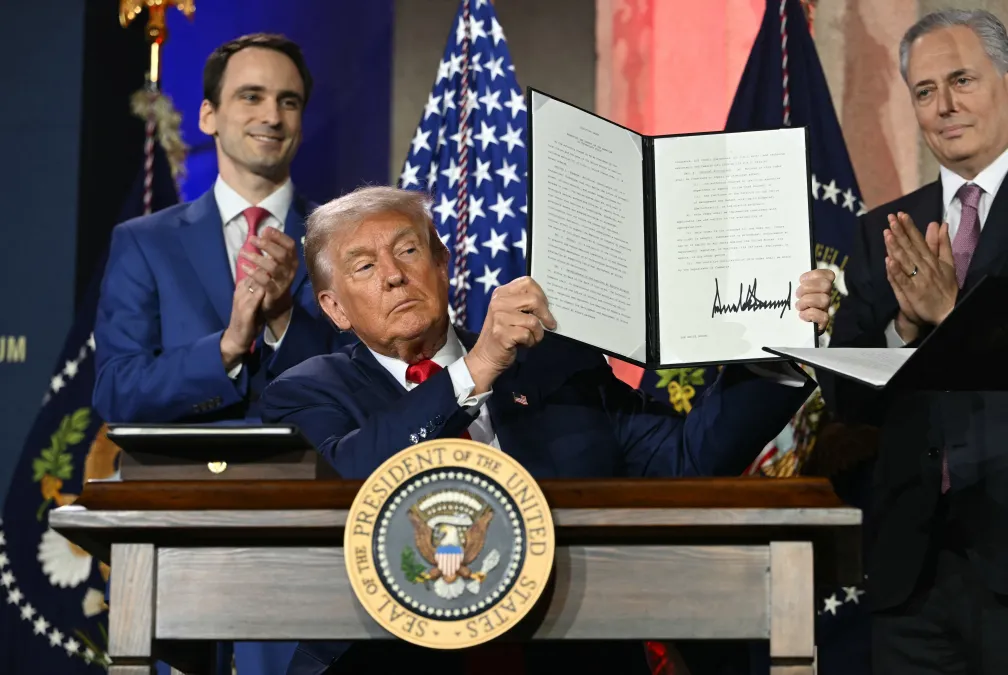In a sweeping political and technological pivot, President Donald Trump signed three aggressive executive orders in late July 2025 aimed at removing ideological bias from artificial intelligence used by federal agencies. Dubbed as a war on “woke AI,” this initiative is already sending shockwaves through the global AI landscape, reigniting fierce debates over censorship, neutrality, regulatory overreach, and the very nature of machine intelligence.
With these orders, the U.S. government isn’t just reshaping procurement policy—it’s trying to reprogram the values AI systems are allowed to express.
Executive Order Breakdown: “Preventing Woke AI in the Federal Government”
This core executive order mandates that AI models acquired or used by federal agencies must demonstrate “ideological neutrality”, be “accurate,” and avoid “promoting DEI ideologies,” which include diversity, equity, inclusion, critical race theory, and concepts related to systemic bias or social justice.
Key Stipulations:
- Federal Contract Requirements: Agencies may not procure AI tools that promote specific ideologies or DEI content. Contractors must certify ideological neutrality.
- Redefining Trustworthiness: The order invokes Trump’s 2020 AI principles but now ties “trustworthy” to ideological exclusion, particularly eliminating models that discuss systemic racism or gender identity in supportive terms.
- Application Scope: Applies across sectors—from health systems to border surveillance tools, education platforms, and federal chatbot assistants.
Critics argue this creates a new ideological orthodoxy under the banner of neutrality, where AI developers must filter outputs to conform to a politically conservative worldview to qualify for lucrative government contracts.
National AI Action Plan: Deregulation Meets Ideological Policing
Accompanying the executive orders is the 28-page “Winning the Race: America’s AI Action Plan,” which envisions the U.S. as a “global AI hegemon” by removing regulation, streamlining infrastructure development, and promoting ideologically filtered American AI systems worldwide.
Major Proposals Include:
- Federal Preemption of State Laws: States with stringent AI regulations, such as California or New York, may lose federal AI funding unless they align with Trump’s deregulatory approach.
- Open-Source Encouragement: While promoting open innovation, this may paradoxically limit model expressiveness through neutrality mandates.
- Export-Oriented Strategy: Orders the Commerce Department to promote a U.S.-built AI “stack” to allies and trade partners, potentially reshaping international norms around AI ethics and safety.
This document has drawn both praise from industry insiders and alarm from academics and ethicists, concerned about how AI’s social responsibilities are being recast into a culture war battleground.
Companion Orders: Accelerating Infrastructure, Weakening Oversight
1. AI Infrastructure Order
- Removes environmental and DEI-related restrictions for AI-related data centers and chip manufacturing on federal lands.
- Fast-tracks AI infrastructure projects, with critics warning this may sideline Indigenous land rights and climate impact assessments.
2. Global AI Strategy Order
- Mandates the State and Commerce Departments to “champion U.S. AI products” globally and oppose foreign digital sovereignty laws that hinder U.S. dominance.
- Positions American AI as ideologically distinct from EU or Chinese models—leaning toward deregulated, “free speech-maximalist” outputs.
Ideological Neutrality or Political Weaponization?
Experts in machine learning, natural language processing, and ethics warn that the idea of “ideologically neutral” AI is technically unfeasible and often subjective.
“You can’t train AI without making value choices—about which data to use, what biases to correct, and what guardrails to impose,” explains Dr. Mia Rodríguez, a Stanford AI ethicist. “Pretending neutrality means endorsing the status quo or a specific worldview—often unconsciously.”
Others argue that AI developers are now caught between political pressures from both the left and the right. While progressive groups push for models that recognize social inequality and inclusive language, Trump’s policies demand silence or denial of such topics.
Industry Impact: Incentivizing Self-Censorship?
Although the executive orders target only federal procurement, their real-world impact is likely to ripple far beyond. Tech giants like Microsoft, OpenAI, Anthropic, and Google DeepMind, which serve both public and private sectors, may feel pressure to create “neutral-compliant” versions of their models across the board.
This could lead to:
- AI model bifurcation, where companies offer different versions of the same LLM for public and private use.
- Internal moderation conflicts, as teams are forced to re-engineer outputs to fit ideologically prescribed guidelines.
- Contract favoritism, as startups with more “neutral” branding may win over larger incumbents unwilling to adjust output behavior.
Already, advisors such as David Sacks, Chris Rufo, and Vivek Ramaswamy—with strong anti-DEI positions—are reportedly involved in shaping this policy, raising questions over how much of it is industry-driven vs. ideologically engineered.
International Fallout and Legal Questions
Global Regulatory Clash
Trump’s AI plan places the U.S. at odds with:
- The EU’s AI Act, which demands transparency and human rights safeguards.
- China’s AI censorship regime, which Trump seeks to differentiate from—but mirrors in some ideological enforcement aspects.
Legal Uncertainty
- Constitutional scholars suggest the neutrality mandate could face First Amendment challenges, especially if it coerces private developers to suppress particular speech to qualify for contracts.
State Pushback
- Progressive governors in states like California may sue or ignore the mandates, setting up a battle between federal funding and state sovereignty in tech regulation.
Final Analysis: A Tech Frontier or a Partisan Minefield?
Trump’s executive orders mark an unprecedented fusion of AI policy and political ideology. While billed as a push for free markets and innovation, the real message is unmistakable: conform your AI to the government’s definition of “truth” or lose access to the world’s largest client.
This could lead to a chilling effect on AI development, where scientific objectivity is replaced by partisan gatekeeping, and the pursuit of truly safe, unbiased AI gets lost in the ideological shuffle.
The future of AI in America now hinges on a fundamental question: Should machines be neutral—or should they be free?









